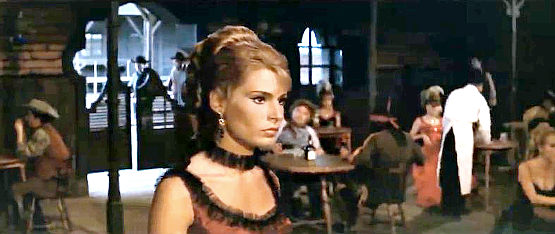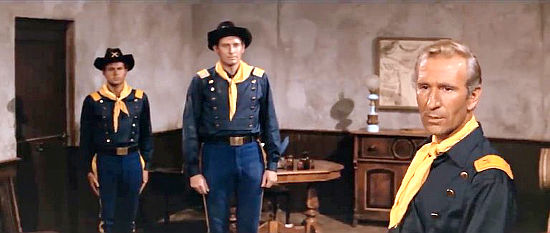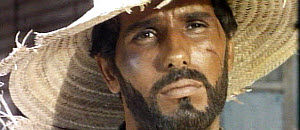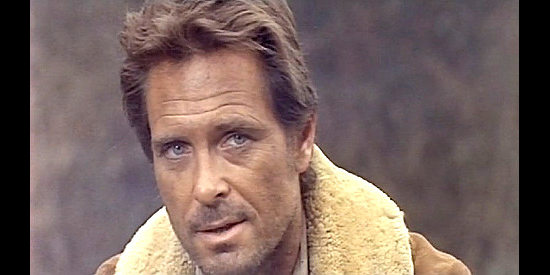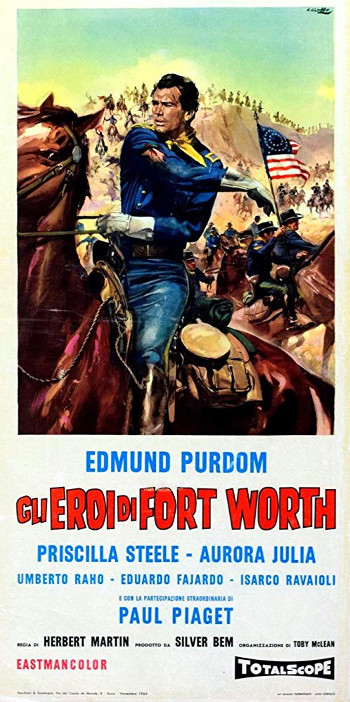 The year is 1863. And while the Civil War rages back east, a Confederate regiment is trying to make its way through Texas to Mexico. Problem is, the Union 5th and 7th cavalry are blocking the escape route.
The year is 1863. And while the Civil War rages back east, a Confederate regiment is trying to make its way through Texas to Mexico. Problem is, the Union 5th and 7th cavalry are blocking the escape route.
So the Confederates, using Col. George Bonnett (Eduardo Fajardo) as an intermediary, form an alliance with Apache Chief Wild Horse.
The plan is simple: Wild Horse’s warriors will attack a nearby settlement, luring the Union cavalry out of the protection of the fort. Then more Indians will attack the undermanned fort.
And that strategy works to perfection, leading to the annihilation of the 5th Cavalry. Defeating the 7th with the same plan might not be as easy,
The 7th has a reliable junior officer in Maj. Sam Allison (Paul Piaget). And he’s counting on an assist from reluctant Maj. Sugar Patterson (Edmund Purdom), who’s time in uniform is almost up and who would rather be drinking and womanizing than soldiering.
At least until a pretty Indian girl named Amanda (Monica Randall) catches his eye. Then there’s a question of what to do with the pretty saloon singer named Nelly (Ida Galli). As harmless as she looks, could she really be a Confederate spy?

Edmund Purdom as Sugar Patterson, trying to retire from the Army with little success in Assault on Fort Texan (1965)
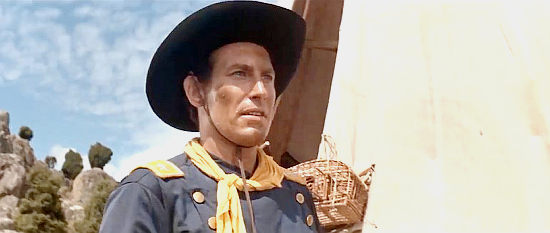
Paul Piaget as Maj. Sam Allison dispatches a carrier pigeon with important news in Assault on Fort Texan (1965)
Take the Civil War, add a horde of marauding Apache, two lovely ladies and a pair of large-scale cavalry vs. Indian battles, and you should be able to put together an entertaining Western.
Unfortunately, this film is too silly too often to be taken the least bit seriously.
Take the stagecoach robbery that opens the film. A gun battle breaks out in which everyone is killed but the stage driver, the shotgun guard and two female passengers. One of the females says everyone is dead; they might as well get going. And they do, leaving the heroic male passengers lying dead in the dust with the bandits!
It’s a sign of things to come. Later, the commander of the Union fort dies in a scene that must be seen to be believed. Then, during his funeral ceremony, a warning bell rings. Indians are attacking a nearby settlement; it might be wiped out.
Too damn bad, decides the new commanding officer. The ceremony will go on, regardless of how many settlers are being massacred just short charge away.
Paul Piaget plays the straight-laced officer who gives that order, but Maj. Sugar Patterson is the star of this show. He’s a lovable rogue who opens the film in the guardhouse, for insubordination, of course.
He’s decorated his cell with drawings of shapely women and his time of service is about to run out. But he keeps finding himself being drawn back into the action, both out of self-preservation and a sense of duty.
One night, he heads out to scout an Indian village with Piaget’s character. Moments later, he’s kissing one of the prettiest little Indian squaws you’ll ever find in a Spaghetti Western.
Turns out she’s named Amanda. And later on, she plays guitar as a ruse so her new girlfriend Nelly can escape from Sugar. Yep, more silliness.
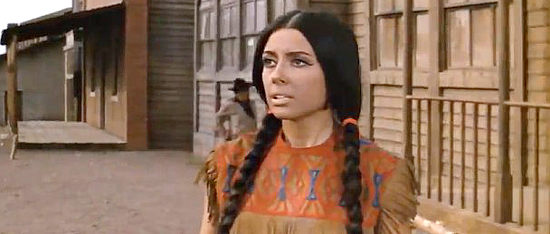
Monica Randall as Anna watches Sugar Patterson ride into danger again in Assault on Fort Texan (1965)
Directed by:
Alberto De Martino
as Martin Herbert
Cast:
Edmund Purdom … Sugar Patterson
Paul Piaget … Maj. Sam Allison
Eduardo Fajardo … Col. George Bonnett
Monica Randall … Anna
as Aurora Julia
Ida Galli … Nelly Bonnett
as Priscilla Steele
Isarco Ravaioli … Lt. Webb
Rafael Albaicin … Chief Wild Horse
Tomas Blanco … Confederate general
Umberto Raho … Col. Maxfield
Jose Marco … Gen. Quantrill
Victor Bayo … Confederate officer
Emilio Rodriguez … Wagonmaster
Runtime: 100 min.
aka:
Gli eroi di Fort Worth
Charge of the Seventh Cavalry
Heroes of Forth Worth
Music: Carlo Rustichelli / Manuel Parada
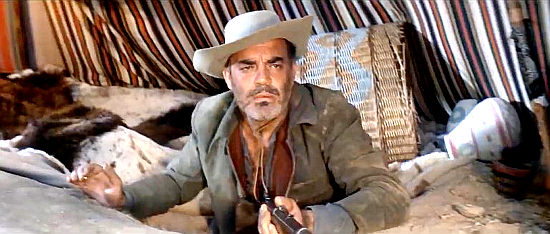
Eduardo Fajardo as Col. George Bonnett, the Confederate officer returning Apache help in Assault on Fort Texan (1965)
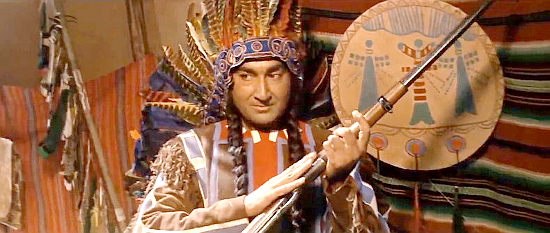
Rafael Albaicin as Chief Wild Horse, admiring a new rifle provided by the Confederates in Assault on Fort Texan (1965)
Memorable lines:
Saloon girl: “Nelly, go over and hustle those fellars, or the boss will be madder than a bobcat.”
Nelly: “Bet your life a mad boss is better than to submit to the insults of those whiskey-breathing sobs.”
Sugar Patterson, to the major, who’s just asked him to help scout the Indian village: “I managed to save my skin while I was with the Army, and now you expect me to go get myself killed when I’m a civilian?”
Sugar Patterson, looking down at an unconscious Indian brave, who was just bashed in the head with a rock by the Indian girl Sugar was caught kissing: “Who was that?”
Anna, the Indian girl: “He was going to marry me. But I’m not in love with him.”
Sugar: “I can see that.”
Sugar Patterson, who has a habit of drawing pretty girls on walls, to Maj. Shea: “Oh, I almost forgot, I left a couple girls for you in my room. Have fun.”
Nelly to Major Shea: “I keep on telling you. I swear that you can trust me. I’m just a woman, major, not a heroine.”
Confederate renegade of the settlers bound for Fort Worth: “They’re almost all women, colonel. This time, it should be easy.”
Col. George Bonnett: “Even women can be very troublesome. Their ability is often surprising.”
Lookout: “Indians are attacking the village. They’re all over the place, sir! It’s a massacre!”
Maj. Shea: “Hold fast. The (funeral) service will continue.”

Edmund Purdom as Sugar Patterson and Isarco Ravaioli as Lt. Webb on the lookout for trouble in Assault on Fort Texan (1965)
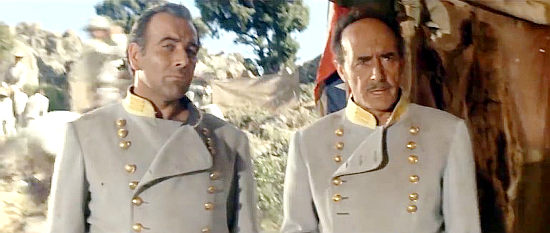
Jose Marco as Gen. Quantrill and Tomas Blanco as his commanding officer work on a battle plan in Assault on Fort Texan (1965)
Trivia:
The film is notable as marking the European Western debut of Ida Galli. She’d go on to become one of the best known female actresses in Spaghetti Westerns as Evelyn Stewart, largely thanks to starring roles opposite Giuliano Gemma in “Blood for a Silver Dollar” (1965) and “Adios Gringo” (1965). She’d wind up appearing in more than a dozen European Westerns from 1965 to 1972.
Edmund Purdom, our star here, probably isn’t a well-known name, even to Spaghetti fans. But he was top-billed in three other European Westerns, “The Last Ride to Sante Cruz” (1964), “Shoot to Kill” (1965) and “Gun Shy Piluk” (1968). He’d moved to Italy after Hollywood roles dried up, despite his early success as star of the big-budget “The Egyptian” (1954), which had critics proclaiming him one of films most promising actors.
According to IMDb, Purdom was honored with having his prints placed outside Grauman’s Chinese Theater following the release of “The Egyptian.” The film flopped; the prints removed. Yul Brynner’s prints are now reportedly in the same spot.

Edmund Purdom as Sugar Patterson, flanked by Ida Galli (Priscilla Steele) as Nelly and Monica Randall as Anna in Assault on Fort Texan (1965)
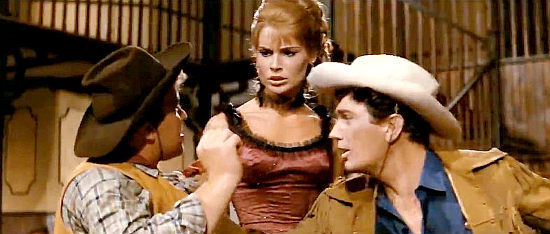
Edmund Purdom as Sugar Patterson protects Nelly (Ida Galli as Priscilla Steele) from a rude cowboy in Assault on Fort Texan (1965)

Edmund Purdom as Sugar Patterson works on another drawing of a lovely lady as part of a jailbreak ploy in Assault on Fort Texan (1965)

Monica Randall as Anna erasing the erotic artwork of boyfriend Sugar Patterson (Edmund Purdom) in Assault on Fort Texan (1965)
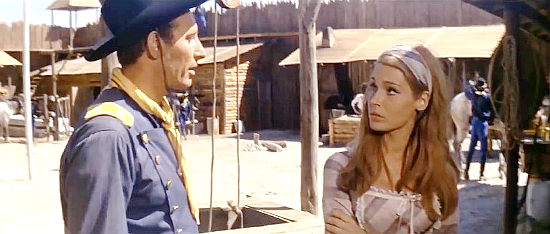
Ida Galli (Priscilla Steele) trying to convince Maj. Sam Allison that she’s ‘just a woman, not a heroine’ in Assault on Fort Texan (1965)

